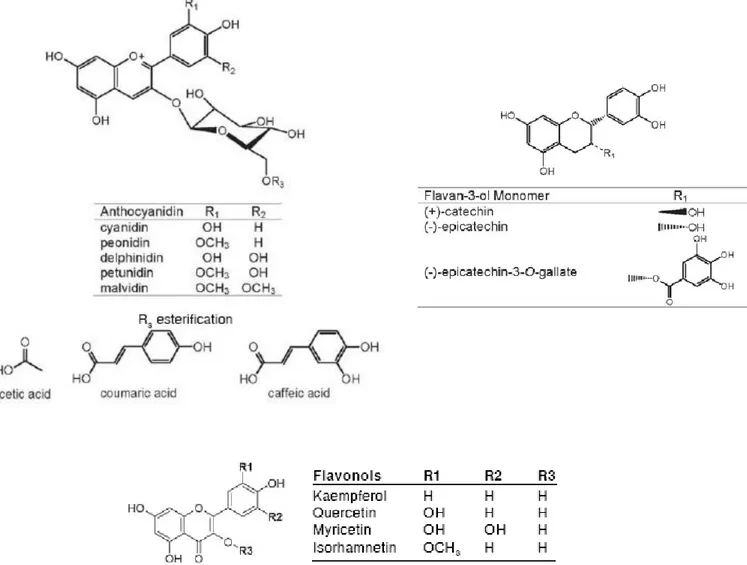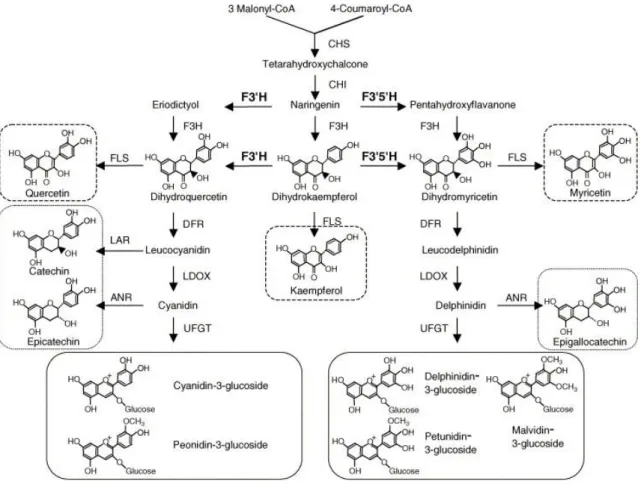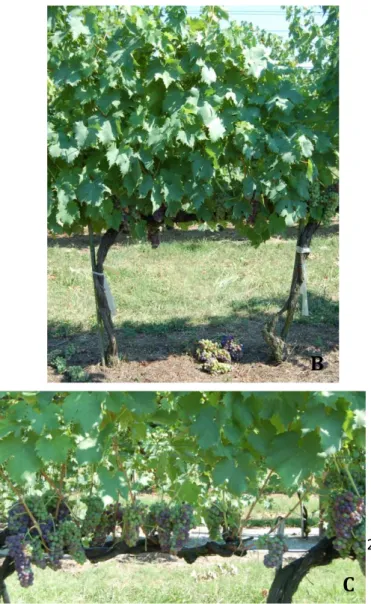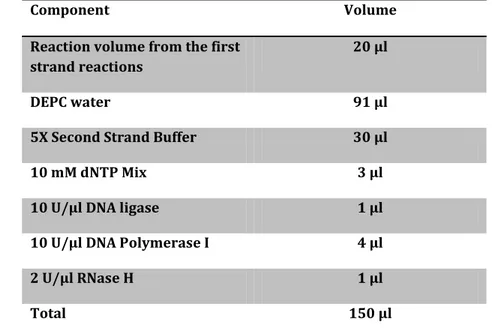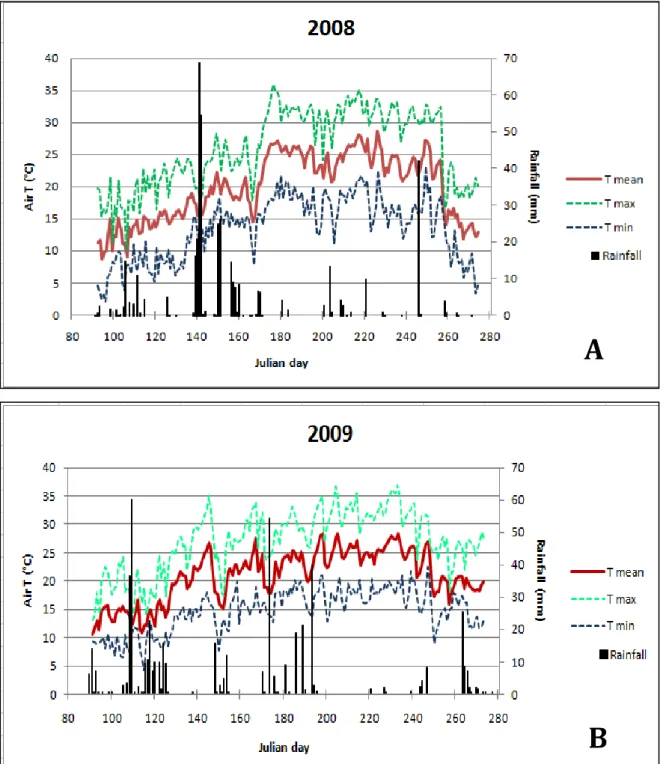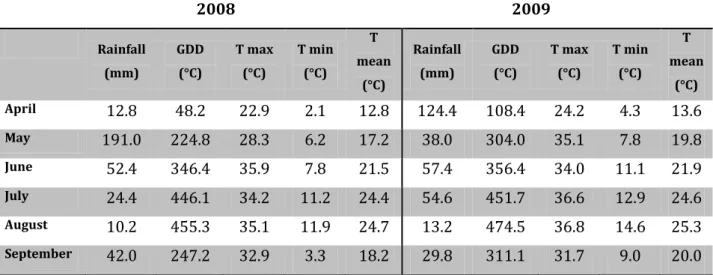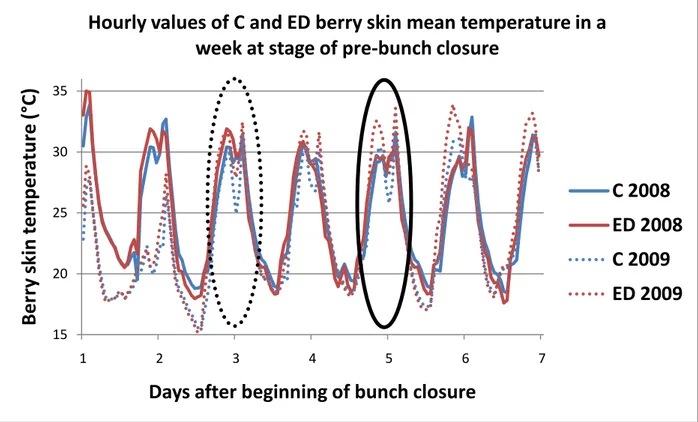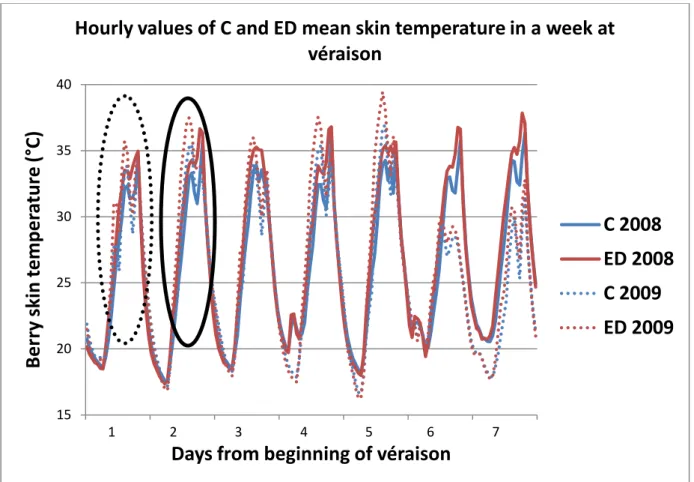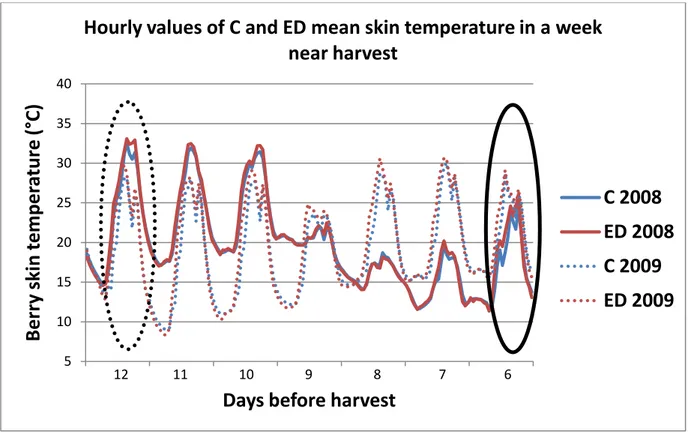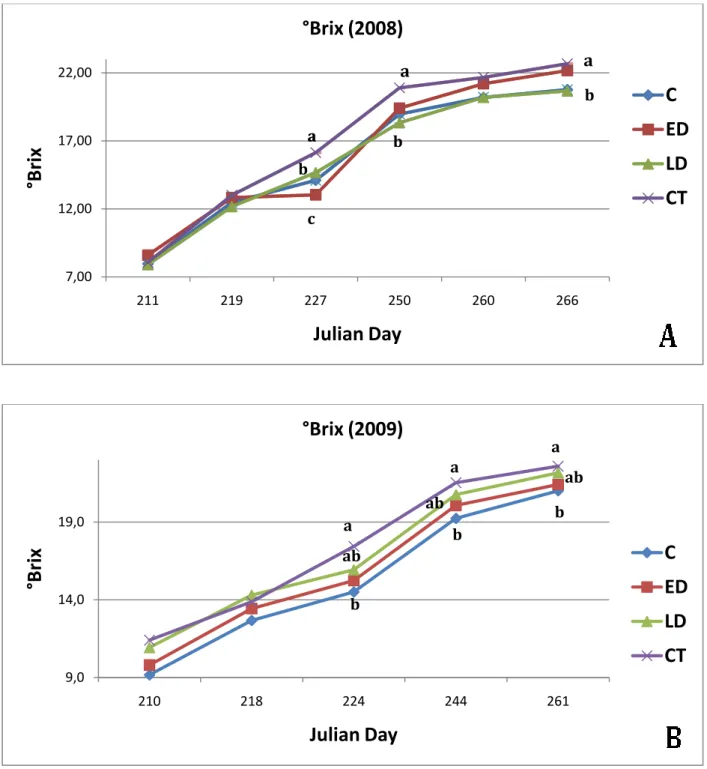A
A
l
l
m
m
a
a
M
M
a
a
t
t
e
e
r
r
S
S
t
t
u
u
d
d
i
i
o
o
r
r
u
u
m
m
–
–
U
U
n
n
i
i
v
v
e
e
r
r
s
s
i
i
t
t
à
à
d
d
i
i
B
B
o
o
l
l
o
o
g
g
n
n
a
a
DOTTORATO DI RICERCA
Colture arboree ed agrosistemi forestali, ornamentali e
paesaggistici
Ciclo XXII
Settore scientifico disciplinare di afferenza:
AGR/03- Colture Arboree
R
R
e
e
s
s
e
e
a
a
r
r
c
c
h
h
e
e
s
s
o
o
n
n
b
b
e
e
r
r
r
r
y
y
c
c
o
o
m
m
p
p
o
o
s
s
i
i
t
t
i
i
o
o
n
n
i
i
n
n
r
r
e
e
d
d
g
g
r
r
a
a
p
p
e
e
:
:
a
a
g
g
r
r
o
o
n
n
o
o
m
m
i
i
c
c
a
a
l
l
,
,
b
b
i
i
o
o
c
c
h
h
e
e
m
m
i
i
c
c
a
a
l
l
a
a
n
n
d
d
m
m
o
o
l
l
e
e
c
c
u
u
l
l
a
a
r
r
a
a
p
p
p
p
r
r
o
o
a
a
c
c
h
h
e
e
s
s
Presentata da:
Dott.ssa Chiara Pastore
Coordinatore Dottorato:
Relatore:
Prof. Luca Corelli Grappadelli
Dr.ssa Ilaria Filippetti
Co-relatore:
Prof. Mario Pezzotti
Esame finale anno 2010
I
INDEX
1.0 GENERAL INTRODUCTION 1
1.1 Dynamic of grape berry growth 1
1.2. Berry ripening and berry composition 3
1.2.1 Sugars 4
1.2.2 Organic acids 5
1.2.3 Phenolic compounds 5
1.2.3.1 Non-flavonoids 5
1.2.3.2 Flavonoids 6
1.3 Biosynthesis of flavonoids in red grape berry 9
1.3.1 Synthesis of the early products of the phenylpropanoid pathway 9
1.3.2 Specific steps towards flavonoid biosynthesis: structural genes involved in flavonols,
flavan-3-ols and anthocyanin biosynthesis 10
1.4 Subcellular compartmentation and transport mechanisms of flavonoids in red grape
berry 14
1.5 Flavonoid gene expression during berry development 15 1.6 Regulatory genes of the flavonoid biosynthesis pathway 16
1.6.1 Regulation of anthocyanin biosynthesis 16
1.6.2 Regulation of flavonols and proanthocyanidins biosynthesis 19
1.7 Factors affecting flavonoids biosynthesis 20
1.7.1 Factors affecting anthocyanins amount and composition: sugars, light and temperature 20 1.7.1.1 Sugars effect on anthocyanin amount and composition: flavonoids gene
sugars-induced 20
1.7.1.2 Light and temperature effects on anthocyanin amount and composition 21
1.7.1.3. Light influence on anthocyanin gene expression 22
1.7.1.4 Temperature influence on anthocyanin gene expression 23
1.7.2 Light effect on flavonols biosynthesis 23
1.8 Cultural practices improving grape berry composition 23
1.8.1 Pre-bloom defoliation 24
1.8.2 Véraison defoliation 25
1.8.3 Cluster thinning 26
II
EXPERIMENT 1
29
2.0 MATERIAL and METHODS 29
2.1 Plant material and leaf area measurements 29
2.2 Temperature monitoring 31
2.3 Berry sampling 31
2.4 Monitoring of berry ripening 32
2.5 Evaluation of clusters morphology and analyses at harvest 32
2.6 HPLC analyses of anthocyanins and flavonols 32
2.7 Statistical analyses 33
2.8 Microarray analyses 34
2.8.1. RNA extraction and RNA evaluation 34
2.8.2. Synthesis of cDNA 34
2.8.4 RNase A Cleanup and cDNA precipitation and evaluation 35
2.8.5 Sample labeling 36
2.8.6 Hybridization and washing 36
2.8.7 Array scanning, data extraction and normalization 37
2.8.8 Microarray data analysis 38
3.0 RESULTS AND DISCUSSION 39
3.1 Agro-meterological data and physiological and vegetative measurements 39
3.1.1. Agro-meteorological data 39
3.1.2 Effects of defoliation treatments on leaf area 40
3.1.3 Monitoring of berry skin temperature in clusters of C and ED vines 42
3.2 Monitor of berry ripening and yields components at harvest 48
3.2.1 Monitor of berry ripening 48
3.2.2 Evaluation of cluster morphology 52
3.3 Flavonoids compounds analyses 54
3.3.1 Analyses of anthocyanins amount and composition 54
3.3.2 Analyses of flavonols amount and composition in 2008 season 60
3.4 Results and discussion of transcriptional analyses 63
3.4.1 Extraction and quality evaluation of total RNA 63
3.4.2 NimbleGen chip hybridization 63
3.4.3 Principal Component Analysis 64
3.4.4 Two-class unpaired comparison analyses 66
3.4.5 Annotation of the differentially expressed genes 67
3.4.6 Differentially expressed genes at end of véraison 69
3.4.7 Differentially expressed genes belonging to “carbohydrate metabolic process" functional
III
3.4.8 Genes involved in “response to stimulus” functional category 83
3.4.8.1 Genes involved in oxidative stress response 83
3.4.8.2 Genes involved in response to high temperature 84
3.4.9 Differential expressed genes involved in flavonoid biosynthesis 90
3.4.9.1. Structural genes involved in flavonoid biosynthesis 90
3.4.9.2. Genes involved in flavonoids composition 91
3.4.9.3. Genes involved in flavonoids transcriptional regulation 94
3.4.10 Differentially expressed genes at harvest 99
EXPERIMENT 2
102
4.0 MATERIAL and METHODS 102
4.1 Plant material 102
4.2 Measurements of berry temperature 102
4.3 Berry sampling 103
4.4 Analyses at harvest 103
4.5 HPLC analyses of anthocyanins and flavonols 103
4.6 Statistical analyses 103
5.0 RESULTS AND DISCUSSION 105
5.1 Physiological and vegetative-productive measurements at harvest 105
5.1.1 Effects of véraison defoliation on bunches temperature and exposure 105
5.1.2 Vegetative-productive measurements at harvest 107
5.2 Flavonoids compounds analyses 108
5.2.1 Analyses of anthocyanin amount and composition at harvest 108
5.2.2 Analyses of flavonols amount and composition at harvest 110
6.0 GENERAL CONCLUSION 112
1
Figure 1. Changes in grape berry diameter (mm) andcomposition (Brix Degree and titrable acidity, g/L) during berry development (Deluc et al., 2007).
1.0 GENERAL INTRODUCTION 1.1 Dynamic of grape berry growth
According to botanical classification grape fruit (pericarp) is classified as a berry. It is a simple fruit, consisting of skin (exocarp), flesh (mesocarp) and a thin internal epidermis layer which
separate flesh from seeds
(endocarp). Exocarp represents at ripening the 5-20% of berry fresh weight and it is constituted by one epidermal layer, in the exterior part, coated with cuticle and
epicuticular waxes (pruin).
Internally in the skin, there are
11-12 ipodermal layers with
collenchimatic cells and idioblasts. Mesocarp is made up by 25-30
parenchimatic cells layers.
Endocarp is constituted by one very thin epidermal layer and 2-3 collenchimatic cells layers (Failla, 2007).
Grape berry growth is described by a double-sigmoid curve, which can be divided into three major phases, each one involving changes
in berry morphology and
composition (Fig.1). In the first phase (I), which begins immediately after bloom, berry growth is due to rapid cell division and subsequent expansion. At this phase, berry seeds begin to develop and the main biochemical changes involve the increase in organic acid (mainly malate and tartrate), which reaches the maximum at the end of phase I. Tannins and hydroxycinnamates are synthesized at this stage. In the second phase (II, lag phase) there is no increase in berry size, seeds development go through and embryo reaches maturity. At the end of this stage glucose and fructose begin to accumulate. Véraison, the onset of berry ripening, marks the start of the last phase (III). This phase is characterized by a new cellular expansion, determining an increase in berry size and at this stage berry also begins to soften. The main biochemical changes involve colour development, which
2
Figure 2. Distribution of annotated unigenes, according to their functional categories, with a two-fold or greater change in abundance within the three main phases of berry development (Deluc et al., 2007)starts towards anthocyanin accumulation and chlorophyll degradation in the skin of red grapes. At the same time sugars content increase, organic acid concentration decline, with subsequent pH increase, and flavor compounds and volatile aroma (derived from terpenoids) are synthesized.
At molecular level, a wide reprogramming of trascriptome and metabolome has to occur to promote berry growth. Recently Deluc et al., 2007, have characterized all the changes in the trascriptome of Cabernet Sauvignon during berry development (Fig.2). Approximately 60% of total transcripts were differentially expressed in the three different stages of berry growth. Genes for biogenesis of cellular components, transport regulation and energy are over expressed in phase I. In phase II there is a large
number of transcripts
involved in transcription, storage proteins synthesis and metabolism; in phase III was observed an increase of transcripts for protein fate and synthesis and for cell cycle and DNA processing.
Many endogenous and exogenous factors influence berry growth.
Among the endogenous factors growth factors play
surely a key role.
Application of exogenous ethylene at 8 weeks after anthesis cause an increase in berry growth but a decrease in average cell size (Hale et
al., 1970). Auxines role in
berry development is
controversial. Some authors
reported that auxines promote cell division and expansion and that their concentration reaches the maximum in phase I of berry growth (Cawthon and Morris, 1982). Gibberellic acid concentration is high just after anthesis, but decrease until the beginning of phase II, where there is a second peak of active gibberellin compounds. Gibberellins could have a role in cells enlargement (Coombe, 1971).
Among exogenous factors, berry development is closely related to water availability in the soil. Fruit volumetric growth is in fact primarily due to water accumulation and during berry
3
development is necessary a coordination between water and solute transport to maintain cells turgor. Water stress leads generally to smaller fruits (Roby et al., 2004). Also light and temperature, which are strictly linked, affect berry growth. Experiments conducted under controlled conditions have demonstrated that berry growth increase when increase light exposure (Dookozlian and Kliewer, 1996) and this suggests that probably light stimulates cell division or cell expansion in grape berries (Dookozlian, 2000). These results can’t be confirmed in field conditions, where, when light increase, are often involved higher temperature and subsequent berry dehydration (Bergqvist
et al., 2001). Temperature influences in fact both grape cell division and expansion. The optimum
temperature for berry growth is among 20°-25°C. Stage I of berry growth is the most sensible to high temperature: temperature reaching value of 35°C reduces growth rate and berry size at harvest (Dookozlian, 2000). Among macronutrients, potassium seems to be essential for grape berry growth and development. After véraison, an increase in potassium concentration in the berry is observed and it is compatible with its role in regulation of osmotic potential, turgor maintenance and growth control (Conde et al., 2007).
1.2. Berry ripening and berry composition
Dynamic of berry ripening is extremely variable among different varieties, among one year from another for the same variety, among different clusters on the same vine and vineyard and among different berries on the same cluster. The nature of the signal that promotes the beginning of berry ripening seems to be related to the same plant endogenous and exogenous factors, as previously seen for berry ripening. Among growth factors, it has been demonstrated that pre véraison berries exposed to abscisic acid accelerate the onset of ripening (Coombe, 1992). On the contrary, even if grape is considered a non-climacteric fruit, it has been reported that ethylene inhibitors applied at 4,5,6,7 weeks after anthesis delay widely berry ripening (Hale et al., 1970). In the same way, treatments of berries with a synthetic auxine-like compound (BTOA) caused a delay in the onset of berry ripening (Davies et al., 1997). Water stress during berry ripening alters berry composition, causing generally an increase in sugars and in skin anthocyanin and tannin (Roby et al., 2004). Timing of water deficit is important, because if it occurs at post-véraison sugars could decrease (Keller et al., 2006). Low light causes a decrease in the rate of berry ripening, with a reduction in sugar and phenolic compounds content and an increase in acidity (Smart et al., 1988). Regards to the temperature, the specific number of heat units (degree days, DD), that determines rate of berry ripening, is typical of each variety. In general low temperatures delay ripening, even if excessively high temperature after véraison may lead to the same result (Dokoozlian, 2000).
As it was seen, the dynamic of berry ripening is fundamental to determine final berry composition and as a consequence grape quality. Sugars, organic acids and phenolic compounds are the main biochemical components of grape berry.
4
1.2.1 SugarsSugar accumulation in grape berries is an important phenomenon which impact on alcohol amount in wine. At the beginning of berry development, sugars are produced by the green berries, while subsequently berry becomes a typical “sink” organ and uses carbohydrates produced by photosynthesis of leaves. Sucrose produced by leaves is then transported for long distance to berries into the phloem. From véraison xylem flow is almost impeded, hence water may reach berries via phloem with sugars. Sucrose is loaded into the phloem by either a symplastic or apoplastic mechanism. In the first mechanism, plasmodesmata are involved; in the second mechanism energy is required and sucrose moves across membranes towards sugars transporters.
Functionally, we distinguish two types of sugars transporters: symporters, which transport sugars in the same direction of the proton gradient, and antiporters, which transport sugars against the proton gradient. Upon its arrival in the phloem of the berry, sucrose may be unloaded. The mechanism of unloading sucrose from the phloem is less clear, even if there are evidences of symplastic and apoplastic mechanisms of unloading. Both disaccharide (DST) and monosaccharide transporters (MST) have been found in plants (Williams et al., 2000). Sucrose, the predominant sugar transported in the phloem, accumulates in grape berry in form of glucose and fructose. So far, the complete cDNA sequences of six proteins homologue to plasma membrane hexose transporters (VvHT1, VvHT2, VvHT3, VvHT4, VvHT5, VvHT6) have been cloned. Functionally, only VvHT1 has been characterized: it is a high affinity H+-dependent symporters, which could transport different
monosaccharides. VvHT1 is expressed both in grape leaves and berries. In berries, mRNA for VvHT1 is abundant before véraison and in the late phase of berry ripening (Vignault et al., 2005). VvHT1 protein levels are high only when berries are green because the protein is not present in ripening berries. Since at the end of berry ripening the glucose/fructose ratio is approximately equal to 1, the cleavage of sucrose may be catalysed mainly by invertase. Invertases are enzymes that produce one molecule of glucose and one molecule of fructose from one molecule of sucrose. Different invertase isoforms are localized in the cell wall (insoluble invertases), cytoplasm and vacuole (soluble invertases). Role of cell wall invertase may be to promote sucrose unloading from the phloem in order to maintain the sucrose concentration gradient and therefore sink strength. GIN1 and GIN2 are two vacuolar invertases cloned from grape berries. Their expression level reaches its maximum at the beginning of berry growth and declines when sugar accumulation starts (Boss and Davies, 2001).
Various parameters, including light, water and ion status, hormones and plant health regulate sugar accumulation in grape berry towards a complex mechanism (Conde et al., 2007). Sugars transporters are tightly controlled and there are several levels (transcriptional or post-transcriptional mechanisms) at which regulation might occur.
Main role of sugars in grape berry is contribute to provide the carbon skeleton of many compounds (such as organic acids or amino acids) and to be energy sources for cells. By now it is
5
scientifically accepted that sugars play also an important role as signalling molecules in control of growth and development (Rolland et al., 2006).
1.2.2 Organic acids
Tartaric and malic acids generally represent from 69 to 92% of all organic acids in grape berries (Kliewer, 1966). Small amounts of citric, succinic, lactic and acetic acids are also present in the berry.
While tartaric acid is synthesized until véraison, malic acids levels vary highly during berry ripening. Green berries, together with leaves, are the main grape organs able to produce organic acids (Dookozlian, 2000).
Tartaric acid concentration decrease after véraison is mainly due to a dilution effect, since berry volume increase and amount of tartrate remains constant. So far, no enzymes degrading tartaric acid have been ever found in grape.
In contrast, the decrease in malic acid amount at the beginning of ripening is associated with respiration and enzyme degradation as well as dilution effect. Malic acid may be therefore transformed to hexoses or used as energy source. Enzymes responsible for malate synthesis or catabolism exist in citosolic and mitochondrial isoforms and are malate dehydrogenase and NAD-malic enzymes (Conde et al., 2007).
Metabolic changes occurring during grape berry development, together with light and temperature, are the main parameters controlling the malate synthesis/degradation rate (Taureilles-Saurel et al., 1995). Grape berries malic acid concentration at harvest is negatively correlated with temperature during the ripening period. It has been demonstrated that the optimum temperature range for acids synthesis is between 20°C and 25°C and that, with increasing temperature, synthesis of malic acid decrease and catabolic rate accelerate (Kliewer et al., 1967). Even the potassium amount in grape berries could avoid tartrate and malate salts formation and therefore it could cause a reduction of the total acid concentration (Iland and Coombe, 1988).
1.2.3 Phenolic compounds 1.2.3.1 Non-flavonoids
Phenolic compounds of the grape are divided between the non-flavonoids and flavonoids groups.
Hydroxycinnamic acids, benzoic acids and stilbenes belong to the non-flavonoids group (Waterhouse, 2002). The hydroxycinnamates present in grape berries are derivatives of caffeic, p-coumaric and ferulic acids, which are present both in the skin hypodermal cells and in the flesh (Adams, 2006). The form in which they are usually present is esters of tartaric acids. Hydroxycinnamic acids, that are the main phenolic compounds in white wine, are produced in the
6
grape berry before véraison; then the synthesis declines and total amount remains constant. Caftaric acid is the predominant hydroxycinnamates in grape (170 mg/kg) (Kennedy et al., 2006).
Benzoic acids are a minor component in grape berry composition. Six derivatives of benzoic acids: (gallic acid, protocatechuic acid, gentisic acid, p-hydroxybenzoic acid, vanillic acid and syringic acid) have been found in grape berry. Gallic acid is the major benzoic acid present in grape berry and it is present both in skin and seeds. Gallic acid, protocatechuic acid and gentisic acid accumulate at the beginning of berry development; then the synthesis increases reaching a maximum at 80-90 days after full bloom. In contrary, the concentration of p-hydroxybenzoic, acid, vanillic acid and syringic acid varies slightly during berry ripening (Chen et al., 2006).
Stilbenes are found in the skin of the grape berry and in vegetative tissues. Although stilbenes are present in low quantity both in berries and wine, they have aroused a lot of interest because of their effects on human health, in particular for what concern resveratrol (Bavaresco and Fregoni, 2001). The key enzyme in stilbenes biosynthesis is stilbene synthase (STS), which is part of a large multigene family: in grapevine actually 20 genes for STS have been found. STS catalyzes the last step of the well-characterized phenylalanine/polymalonate biosynthetic pathway that brings to the formation of trans-resveratrol (Delaunois et al., 2009). Resveratrol could exist in different forms: in monomeric unit (as dimethylated derivatives, trans-pterostilbene, and as in form of 3-O-β-D-glucoside, trans- and cis-piceid) or in dimer units (viniferins). Stilbene biosynthesis can be constitutive or activated in response to pathogens attack or abiotic elicitors (for example UV radiation, aluminium chloride, ozone, wounding). Constitutive biosynthesis of resveratrol increases in berry grape from véraison to ripening phase. In particular, it has been demonstrated that resveratrol glucosides are preferentially produced in absence of biotic or abiotic elicitors, while
trans-resveratrol represents the inducible form (Gatto et al., 2008).
1.2.3.2 Flavonoids
All flavonoids share a common chemical structure represented by a C15 skeleton (C6-C3-C6, Fig.3). Depending on the position of the linkage of the aromatic ring (B ring) to the benzopyrano moiety (C ring), we can distinguish the
flavonoids (2-phenylbenzopyrans), the
isoflavonoids (3-benzopyrans) and the
neoflavonoids (4-benzopyrans). Based on the degree of oxidation and saturation of the C-ring, the flavonoids may be divided into 8 subclasses (Fig.4). The B ring can further be hydroxylated,
ortho-dihydroxylated or
vicinal-trihydroxylated. Other flavonoids modifications
include methoxylation, O-glycosilation of
Figure 3. Chemical structure of flavonoid molecule (Aron and Kennedy, 2008).
7
Figure 4. Chemical structure of flavonoid subclasses (Aron and Kennedy, 2008).hydroxyl groups or C-glycosilation of flavonoid skeleton carbon atom. Moreover flavonoid glycosides are frequently acylated with aliphatic or aromatic acid molecules (Aron and Kennedy, 2008).
Many physiological roles are attributed to flavonoids in plants: they are able to protect plant from UV radiation; they can act as attractants for pollination and seed dispersal or as deterrents for herbivores. Besides, flavonoids can act as phytoalexins in plant defence against pathogens (Downey
et al., 2006).
In grape are commonly detected different classes of flavonoids: anthocyanins, flavonols and flavan-3-ols (tannins or proanthocyanidins) (Fig.5).
Flavonoids are localized both in berry skin and seeds. In particular, in hypodermal cells of the skin we can found tannins, flavonol, monomeric flavan-3-ols and, in red grape, anthocyanins.
Anthocyanins are pigments and represent the major class of flavonoids of the skin of red grape varieties. The anthocyanins commonly found in grape include delphinidin, cyanidin, petunidin,
peonidin and malvidin-3-O-glucosides, 3-(6-acetyl)-glucosides and 3-(6-p-coumaroyl)-glucosides. In certain grape varieties have been found even traces of peonidin and malvidin 3-(6-caffeoil)-glucoside. Malvidin-3-O-glucoside is the most abundant anthocyanin present in grape.
Monomeric flavan-3-ols (catechin, epicatechin, epigallocatechin) are present in the skin at lower concentrations, while they are present at high concentrations in form of polymers within tannins
8
(proanthocyanidins). Tannins are polymers of different condensed monomers: epicatechin and epigallocatechin constitute the chain of the polymers (“extension” subunits); catechin is present as “terminal” units (Braidot et al., 2008). The mean degree of polymerisation (mDP), which represents the mean length of the tannin chain, is of about 28 in berry skin (Bogs et al., 2005).
The last component of flavonoids in the skin is represented by flavonols, in particular glucosides, galactosides and glucuronides of quercetin, kaempferol and myricetin. In some varieties there are also little amount of isorhamnetin, laricitrin and syringetin (Mattivi et al., 2006).
Flavonoids in the seeds accumulate not only in the external part, but even in the inner layers. Grape seeds are the primary source of flavan-3-ols and tannins in grape berries. Total tannin content is in fact higher in seeds than in skin even if seed tannins have a lower mDP. Even the composition of seed tannins is different comparing to the skin one: in seed tannins generally epigallocatechin is not present and epicatechin gallate is the major constituent of “extension” subunits (Adams, 2006).
Figure 5. Chemical structure of the three main classes of flavonoids present in red grape berry (Kennedy et al., 2005).
9
1.3 Biosynthesis of flavonoids in red grape berryFlavonoids are synthesized within the general phenylpropanoid pathway. From the same precursors and towards specific branches, these pathways bring to the synthesis of anthocyanins, flavonols and proanthocyanidins. The enzymes involved in flavonoid biosynthesis are associated at the cytoplasmic surface of the endoplasmic reticulum and represent a multienzyme complex.
1.3.1 Synthesis of the early products of the phenylpropanoid pathway
PAL is a key enzyme, ubiquitous in plants, which catalyzes one of the first steps in phenylpropanoids biosynthesis, the hydrolysis of ammonia from phenylalanine to produce cinnamic acid. Cinnamic acid is the precursor of all phenolic compounds. Recently in grape was found the subcellular localization of PAL: PAL is present in the cell walls, secondarily thickened walls and parenchyma cells of the berry tissues (Chen et al., 2006). This enzyme, that is a member of a large gene family, has been cloned in many plant species. In tobacco plants, two PAL isoforms have been found: PAL1 that is associated with the endoplasmic reticulum and PAL2 that is able to diffuse through the citosol (Achnine et al., 2004). In grape are probably present 15-20 PAL isoforms (Sparvoli et al., 1994). Ritter and Schulz (2004) have elucidated the crystal structure of the PAL enzyme at high resolution, exploiting its homology with the enzyme Histidine Ammonia Lyase (HAS). PAL has a tetrameric D2-symmetric structure in which the four subunits are tightly linked. For what concern PAL molecular architecture, it is a α-helical protein (52%) with the 5% of the residues organized in β-strands. The mobile N-terminal peptide of 24 amino acids may anchor the enzyme at other cell components. The active centre of PAL is represented by a 4-methylidene-imidazole-5-one (MIO) group, which is derived post-translationally from a tripeptide segment in two autocatalytic dehydration reactions. MIO group is responsible for the unusual nonoxidactive deamination reaction of PAL.
The cinnamic acid produced by PAL is converted to p-coumaric acid towards the action of cinnamate 4-hydrolase (C4H). C4H belongs to the cytochrome P450 monoxygenases family. The enzymes of this family are able to catalyse exothermic reactions that are irreversible. Many cDNAs
encoding C4H were isolated from different plants
(http://drnelson.utmem.edu/CytochromeP450.html). In grape C4H have not yet been cloned, but it’s known that it is present in the chloroplasts and in the nucleus of berry tissues (Chen et al., 2006).
One molecule of p-coumaric acid produced by C4H is condensed with an acetil-CoA molecule to form p-coumaroil-CoA that is the precursor of all the flavonoids. The enzyme which catalyses this reaction is the 4-coumarate:coenzyme A ligase (4CL). 4CL is localized in grape in the secondarily thickened walls and in the parenchyma cells of the berry pulp vascular tissue (Chen et al., 2006). 4CL belongs to a multigene family. In Arabidopsis thaliana there are four members in 4CL family (At4CL1-4). Of the four isoforms only At4CL3 is involved in flavonoids biosynthesis (Hamberger and Hahlbrock, 2004), while the other isoforms participate in lignin production. In grape two
10
(http://compbio.dfci.harvard.edu/tgi/cgibin/tgi/mapTCs.pl?map=map00940&species=grape&gi_dir =vvgi).
It’s very interesting to note that the activities of PAL, C4H and 4CL are really correlated and change concomitantly (Chen et al., 2006).
1.3.2 Specific steps towards flavonoid biosynthesis: structural genes involved in flavonols, flavan-3-ols and anthocyanin biosynthesis
The first enzyme involved specifically in flavonoids biosynthesis is calchone synthase (CHS)(Fig.6). CHS catalyzes the condensation of one molecule of p-coumaroil-CoA with three molecules of malonyl-CoA to produce naringenin chalcone. CHS, as other enzymes involved in the phenylpropanoid metabolism like STS, belongs to a large superfamily of proteins, the family of type III Polykethide Synthase. Until now, three different isoforms of CHS have been found in grape. CHS1 and CHS2 are two different isoforms that are very similar both at nucleotide (92.4% of homology) and at amino acid level (96.7% of homology). The major differences in the nucleotide sequences are present in their 3’ and 5’ untranslated regions and both the proteins encoded by these two isoforms are constituted by 393 amino acid residues. The third isoform (CHS3) is different from CHS1 and CHS3, showing only the 89% of homology. Many differences have been found even in the 3’ and 5’ untranslated region of CHS3, comparing this region with the ones of the other two isoforms. CHS3 encoded for a protein of 389 amino acids. In berry skin of the red cultivars Cabernet Sauvignon and Merlot mRNAs for CHS1, CHS2 and CHS3 were detected in the early stage of berry development (green berries). These levels decrease until véraison and then, after véraison, there is a new increase of these mRNAs accumulation. Among the three different isoforms has been demonstrated that CHS3 accumulates mainly in berry skin of red cultivar after véraison, while there are no differences between the amount of CHS1 and CHS2 in red or white cultivars (Chardonnay) (Goto-Yamamoto et al., 2002). The three dimensional structure of CHS was solved from alfalfa (Medicago
sativa) in the past few years. CHS maintains an αβαβαβ protein fold that is typical of all the
members of the enzyme superfamily of type III Polykethide Synthase (Ferrer et al., 1999).
Naringenin calchone is converted to flavanones (naringenin) to form the flavanoid core towards a stereo-specific ring closure catalysed by chalchone isomerase (CHI). It is believed that existed only one locus encoding for CHI in grapevine and this is compatible with the ability of its substrate to isomerise non enzimatically and with the fact that mutations in CHI are in fact very leaky. Recently, instead, two isoforms of CHI were identified (Jeong et al., 2004). Jez et al., (2000), have crystallized the CHI enzyme in alfalfa. CHI is a functional monomer of 220 amino acid residues that adopts an open-faced β-sandwich fold. The active site of the enzyme is characterized by an apolar environment and by different amino acids that are located in a large β sheet and in a layer of α-helices. On the basis of the CHI sequence, that doesn’t display any detectable homology with other proteins, seems that this enzyme is unique to the plant kingdom.
11
Naringenin is then hydroxylated at position 3 by flavanone 3-hydroxylase (F3H) to form dihydrokaempferol, the flavonols precursor.
Dihydrokaempferol can be substrate of three different enzymes which directly bring to the production of the flavonol kaempferol towards the action of flavonol synthase (FLS), or to the biosynthesis of dihydroquercetin and dihydromyricetin towards the action respectively of flavonoid-3’-hydroxylase (F3’H) and flavonoid-3’5’-hydroxylase (F3’5’H).
These enzymes catalyse the hydroxylation of the B ring of dihydrokaempferol in 3’ or 3’5’ positions. F3’H activity results in the production of cyanidin-like anthocyanins, while F3’5’H action brings to the production of delphinidin anthocyanins species. The cloning of both F3’H and F3’5’H genes from grape has shown that in grape are present two copies of F3’H and several copies of F3’5’H in a single chromosome (Bogs et al., 2006; Castellarin et al., 2006). In flowers of Petunia
Hybrida has been shown that F3’H and F3’5’H can act both on the substrates and products of F3H
(Stolz et al., 1985; Menting et al., 1994).
As previously described, FLS is the key enzyme in the biosynthesis of flavonols. This enzyme employs dihydrokaempferol, dihydroquercetin and dihydromyricetin as substrates to synthesize the flavonol aglicones. FLS is a oxoglutarate dependent dioxygenase, which requires 2-oxoglutarate and ferrous iron for catalytic function. This protein family is characterized by two sets of four β-sheets arranged in an anti-parallel manner. In this rigid structure are housing two conserved motifs essential for binding ferrous iron and 2-oxoglutarate. Protein sequence alignment of FLS form various species, among which Vitis Vinifera FLS, indicated 5 conserved residues, which are present at different sequence positions and determine enzymatic activity (Chua et al., 2008). In Shiraz flower were identified two distinct cDNA encoding for FLS: VvFLS1 and VvFLS2, which have an overlapping region of 425 nucleotides with the 79% of homology at sequence level. As VvFLS2 expression does not change during berry development, it is probable that VvFLS1 is the enzymatic isoform responsible for flavonols synthesis in berry, even if it is also expressed in many other grape organs (leaves, tendrils, pedicels, buds and inflorescence) (Downey et al., 2003).
VvFLS1 directly competes for its substrates with the enzyme dihydroflavonol 4-reductase (DFR), which catalyses the first step in the conversion of dihydroflavonols to proanthocyanidins or anthocyanins. This point of the biosynthetic pathway is a key regulatory point because it determines the direction towards flavonols or proanthocyanidins and anthocyanins synthesis.
DFR is in fact responsible for the NADPH-dependent reduction at the 4 position of the C ring of dihydroquercetin and dihydromyricetin to give respectively leucocyanidin or leucodelphinidin. The sequence of DFR contains most of the motives present in the short-chain dehydrogenase/reductase (SDR) superfamily and the 3D description of the DFR-NADP+-dihydroquercetin ternary complex has
confirmed it (Petit et al., 2007). In a recent study has been demonstrated that the active site of grape DFR can host the flavonols quercetin or myricetin in a similar way to the dihydroflavonol
12
dihydroquercetin. In presence of flavonols, two molecules bind at the same time the catalytic site altering its geometry and leading to the inactive state of the enzyme (Trabelsi et al., 2008).
Leucocyanidin and leucodelphinidin are, in turn, substrates to the next step of the proanthocyanidin and anthocyanin biosyntheses, which involve either anthocyanidin reductase (ANR) and leucocyanidin reductase (LAR) or leucoanthocyanidin dioxygenase (LDOX) and UDP-glucose:flavonoid 3-O-glucosyltransferase (UFGT).
In grape, LAR converts leucocyanidin in the flavan-3-ol (+)-catechin with a NADPH-dependent reduction. ANR acts instead on the products of the enzyme LDOX, which catalyzes the cyanidin and delphinidin production from leucoanthocyanidins. Then ANR uses these substrates to synthesize
respectively (-)-epicatechin and (-)-epicatechin-3-O-gallate (Gagné et al., 2009).
As FLS, also LDOX belongs to a family of 2-oxoglutarate-dependent oxygenase (Nakajima et al., 2006). In a recent work has been demonstrated that in Arabidopsis Thaliana, LDOX could have also a FLS activity in vivo (Stracke et al., 2009). Southern blot experiments conducted on Vitis Vinifera cv. Red Globe have shown that it is present only a single copy of LDOX gene in grapevine (Gollop et
al., 2001).
Figure 6.Diagrammatic representation of the flavonoids biosynthesis pathway. Enzyme abbreviations are as given in the text (Jeong et al., 2006).
13
The anthocyanidins, cyanidin and delphinidin, produced towards the action of LDOX are then stabilized through the addiction of a glucose residue at the 3 position of the C ring. This reaction is catalysed by the enzyme UFGT and allows the anthocyanins transport into the vacuole.
UFGT is the key enzyme in anthocyanin biosynthesis, because it is expressed only in red skin cultivars. It was isolated for the first time as a partial cDNA clone and sequence comparison of the corresponding gene from other species has shown only the 65% of homology (Sparvoli et al., 1994). UFGT seems to be present in grape genome as a single copy and it is interesting to note that its promoter and coding regions have been found also in white cultivar and are similar to the sequences present in their red-skin sports (Kobayashi et al., 2001). The 3-O-glycosilation of anthocyanin is almost always a prerequisite for further modification, as methylation and acylation.
Methoxyl groups are found in three of the main anthocyanins (peonidin, petunidin and malvidin-3-O-glucoside). This reaction brings to more stable compounds for the methylation of the reactive hydroxyl groups and the enzymes responsible are O-methyltransferases (OMTs). The first partial purification and characterization of a methyltransferase catalyzing the methylation of cyanidin-3-glucoside to peonidin-3-glucoside was performed on a cell suspension of Vitis vinifera cv Gamay Freaux. This enzyme is S-adenosyl-L-methionine (SAM)-dependent and it was shown that it has a high substrate specificity, reacting only with cyanidin and not with delphinidin (Bailly et al., 1997). More recently it has been described the identification and the biochemical characterization
of a novel Mg2+-dependent anthocyanin O-methyltransferase (AOMT) from grapevine. This enzyme
belongs to the type 2 OMTs, a group of lower molecular mass (23–27 kD) cation dependent OMT. AOMT showed a preference for 3’, 5’methylation compared to 3’methylation and its transient expression in tobacco (Nicotiana Benthamiana) resulted in a higher accumulation of malvidin-3-rutinoside compared to delphinidin-3-malvidin-3-rutinoside (Hugueney et al., 2009).
Acylation of anthocyanins consists in the addition of an aliphatic acetyl group or an aromatic p-coumaroyl group to the 6’ position of the 3-O -glucoside. The enzymes responsible of this modification are anthocyanin and flavonoid acyltransferases, which are classified into two different categories (aliphatic and aromatic acyltransferases) on the basis of the acyl-donor specificity. Acylated anthocyanins show a low sensivity to pH changes because are more soluble in water and lead to higher anthocyanins structure stability protecting the sugar molecule against degradation by glucosidase (Welch et al., 2008).
Although the flavonoid biosynthetic pathway takes place in the cytoplasm, once the biosynthesis and the additional modifications are complete, the most part of the products are delivered into and stored in distinct cellular compartments as it happens for many other secondary metabolites.
14
1.4 Subcellular compartmentation and transport mechanisms of flavonoids in red grape berryWhile the biosynthetic pathway of flavonoids has been well studied, it is not still possible completely understand the flavonoids transport in plant because several mechanisms could coexist and overlap.
In red cultivars, flavonoids are localized and stored at cellular level mainly in the cell wall and in the vacuoles. Microscopic observations have shown the presence of anthocyanins in a non-complex form in the vacuoles, in the first external layers of the skin hypodermal tissue. In particular anthocyanins have been found in spherical pigmented inclusions, membrane-delimited, known as anthocyanic vacuolar inclusions, which contain also tannins and organic compounds. Moreover anthocyanins are also present in the cytoplasm into vesicles called anthocyanoplasts, which are probably responsible for their transport into the vacuole. Flavan-3-ols and tannins are instead localized both in the vacuoles and in the cell wall of berry skin. Inside the vacuole, tannins are present in the form of free tannins, while in the internal face of tonoplast and in the cell wall they are linked respectively to proteins and to polysaccharides. The composition of tannins from the cell wall compared to those localized in the internal part of the cell is quite similar, even if in the cell wall the mDP is 2-3 times higher than that of the vacuole and tonoplast. Regards to flavonols, with fluorescence induction towards different reagents, it has been demonstrated their localization into the cell wall of spruce needles (Hutzler et al., 1998).
Further the flavonoids transport mediated by a complex vesicle trafficking system, it was supposed also a ligandin transport model, which involves tonoplast primary and secondary active transporters (Grotewold and Davies, 2008). The proposed mechanisms were studied, at the beginning, mainly in A. Thaliana. The first kind of active transporters belong to the ATP-binding cassette (ABC) proteins, which share a common ATP-binding domain. The involvement of the ABC proteins in flavonoids transport was suggested for the first time in the bronze2 (bz2) mutant of maize, defective in the accumulation of anthocyanin in the vacuole (Marss et al., 1995). The bz2 gene encodes for a glutathione S-transferase (GST) and, as ABC proteins have a preference for gluthatione conjugates and their transport activity is stimulated in presence of glutathione, the involvement of ABC proteins in the vacuolar transport of anthocyanin was presumed (Yazaki, 2006). Recently five GSTs were purified from Vitis Vinifera L. Cv. Gamay Fréaux cell suspensions.
The GSTs are all soluble or membrane associated dimers, which catalyse the conjugation of the tripeptide glutathione (γ-Glu-Cis-Gly) to a variety of electrophilic compounds. On the basis of intron structure and protein sequence alignments, three of the five sequences cloned were classified in type τ GST (VvGST2, VvGST3 and VvGST1), while the remaining two in type ϕ GST (VvGST1 and VvGST5). In particular, the transcriptional profiling of VvGST1 and VvGST4 was strongly positive correlated with some key genes in anthocyanins biosynthesis pathway and complementation
15
studies in bz2 maize mutants confirmed their important role in anthocyanins transport, also in increasing the turnover of intermediates (Conn et al., 2008).
Secondary active transport involves, instead, a proton gradient-dependent transport, depending on a preexisisting H+ gradient across the vacuolar membrane generated by vacuolar ATPase and
vacuolar H+-pyrophosphatase (Klein et al., 1996). In Vitis Vinifera L. Cultivar Shiraz Gomez et al.
(2009) reported the identification of genes encoding proteins with high sequence similarity to the Multidrug And Toxic Extrusion (MATE) family and among them anthoMATE1 (AM1) and
anthoMATE3 (AM3) seem to be the most probable candidates as anthocyanin transporters. AM1
and AM3 are expressed mainly in the berry and they are primarily localized in the tonoplast. Different experiments revealed that they are vacuolar H+-dependent transporters specialized in acylated anthocyanins transport. This suggests the existence of alternative mechanisms involved in the transport of glucosylated anthocyanins (Gomez et al., 2009).
Another secondary active transporter, homologue to mammalian bilitranslocase (BTL), has been described both for red (Braidot et al., 2008a) and white grape berries (Bertolini et al., 2009). This protein is a membrane protein of about 31 kDa and, towards immunohistochemical identification, an anti-BTL antibody allows localizing BTL-homologue in the skin of red grape berry and also in vascular bundle of berry pulp. The analysis of the BTL-homologue expression profile in different tissues during ripening has suggested that this protein could have a key role not only in anthocyanin accumulation, but also for intermediate metabolite translocation during berry development, in particular in physiological conditions associated with a low transport efficiency as during the late ripening stage (Braidot et al., 2008b).
1.5 Flavonoid gene expression during berry development
The pattern of flavonoid gene expression is very different among different organs and among the different phases of berry ripening. Data about the trend in gene expression of some structural genes of flavonoid biosynthesis in berry skin compared to flesh, have been published by Boss et al. in 1996 (a) for red cultivar Shiraz. Northern blot analysis of berry skin RNA have shown that the majority of genes involved in flavonoid biosynthesis are just expressed from flowering to 2-4 weeks after full bloom and then after véraison. Only the expression of the gene UDP Glc-Flavonoid 3-O-glucosyl Transferase (UFGT) is strictly linked with véraison phase. In berry flesh all the genes analyzed are expressed at lower levels compared to skin except for Phenylalanine Ammonia Lyase (PAL) and UFGT, whose expression was not detectable in the flesh at any stage of the analysis (Boss
et al., 1996a). Similar experiments conducted in white cultivars have shown that in white berries
UFGT is never expressed (Boss et al., 1996b). The early expression of the genes from CHS to LDOX and FLS, LAR and ANR could be explained by the accumulation of flavonols and tannins in the young berry. Regards to the genes encoding anthocyanin modifying enzymes, it was demonstrated that the gene VvF3’H-1 (the only functional isoform identified) is expressed in berry skin of cultivar
16
Merlot throughout ripening, even if its expression decreases 8–10 weeks after blooming. VvF3'H-1 transcripts increase soon after, at the onset of véraison and shows a secondary peak of expression one week before harvest, concurrently at the peak of anthocyanin content. VvF3'5’H-1 is instead weakly expressed during the first stages of berry ripening and the peak of expression is reached when all berries have turned red. Transcripts of the isoforms long and medium appear at the onset of véraison and lasted till full ripening, while the isogene VvF3'5'H-2-short was constitutively expressed throughout the ripening (Castellarin et al., 2006). ). In cv Shiraz both F3’H and F3’5’H transcripts were detected at flowering and in the early stages of berry ripening, but their expression reaches a maximum one week before and week after véraison respectively (Bogs et al., 2006). Transcriptomic analyses on Shiraz and Nebbiolo grape berries, harvested at different ripening stages, have shown that in these varieties the expression of AOMT follows the same profile. AOMT is not expressed before the onset of ripening, but, after véraison, there is a strong increase in the amount of transcripts during the first weeks and then the expression decreases and remains constant until harvest (Hugueney et al., 2009). In pre- and post véraison stages berries of cultivar Shiraz was studied the transcription of the five isoforms of GST genes identified by Conn et al. (2008). The interesting thing is that the expression of GST is linked not only to berry ripening, but also it seems to be dependent on the kind of isoform. In fact expression of VvGST2, VvGST3 and VvGST4 was found to be until 60-fold higher in post véraison berries compared to green berries, while for VvGST1 and VvGST5 the increase was lower. VvGST1 was instead the most strongly induced in suspension cell cultures in conditions which enhance anthocyanin accumulation. These differences in the transcription profile could be due to interspecies variation or differential response of the five isoforms to specific conditions.
1.6 Regulatory genes of the flavonoid biosynthesis pathway 1.6.1 Regulation of anthocyanin biosynthesis
Among the three classes of flavonoids present in grapevine, the regulation of anthocyanins biosynthesis has been the most studied thanks to the numerous available colour bud sports, which involve alterations in the red or purple berry anthocyanin content. Bud sports are usually infrequent changes in phenotype affecting shoots of woody perennials, but colour bud sports are common and examples in horticultural plants are widespread. Alterations in the anthocyanins of a plant can be in fact very distinct and easily observed and generally have no detrimental effect on the viability of the plant. The molecular basis underlying the appearance of bud sports are not yet well understood.
The study of the genes regulating structural genes expression in anthocyanin biosynthesis was at first done in maize, petunia and snapdragon (Davies and Schwinn, 2003) and then full characterized in Arabidopsis (Broun, 2005). From this researches emerged that three different types of transcription factors play a key roles in regulation of anthocyanin biosynthesis: MYB, bHLH
17
(basic Helix-Loop-Helix) and WDR (WD40 repeats), even if the WD40 proteins function seem to be only to assist MYB and bHLH proteins.
MYB genes are present in plant genomes as different families, which have evolved after duplications of their DNA binding domain. In the DNA binding domains of MYB genes there are 100-160 residues, depending on the number of imperfect repeats (R) of the N-terminal region. The MYB R2R3 subfamily is the most abundant in plants (Martin and Paz-Ares, 1997). The first experience on MYB genes in grapevine was done on the cultivar Kyoho, which belongs to Vitis labruscana (V.
Labrusca x V. Vinifera). With cDNA of ripening berries was constructed a cDNA library and then,
using random primers designed on maize MYB conserved sequences, eight different grape MYB homologue sequences were identified. Among these, only four species of MYB gene can be really identified: MYBA, MYBB, MYBC, and MYBD. The whole cDNA sequences of MYBA and MYBB showed the existence of three different species for MYBA (VlMYBA1-1, VlMYBA1-2 e VlMYBA2) and two for MYBB (VlMYBB1-1 e VlMYBB1-2), which are different in the nucleotide sequence. Transcription analyses revealed that VlMYBA is only weakly expressed before véraison, but immediately after the beginning of anthocyanin accumulation and berry softening, VlMYBA expression rapidly increases. VlMYBB expression was instead detected in all the berry ripening stages analyzed even if also VlMYBB expression increases after véraison. Regards to VlMYBC and VlMYBD, these genes seems to be few linked to berry véraison because the first one is expressed at high levels just at the beginning of ripening and at véraison the transcription decreases; in the case of VlMYBD, the expression was detected only in the early stages of berry ripening. The tight relationship between VlMYBA and berry véraison and anthocyanin accumulation was further confirmed by expression analyses which revealed that VlMYBA transcripts, differentially from the others VlMYB genes identified, were detected only in berry tissues. The introduction of VlMYBA1-1, VlMYBA1-2 e VlMYBA2 in embryos causes the appearance of reddish-purple spots and so the authors concluded that VlMYBA was the transcription factor regulating UFGT expression (Kobayashi et al., 2002). The molecular basis of the regulation of UFGT expression were then confirmed also for Vitis Vinifera and it was shown that VvMYBA was probably responsible of the ancestral differentiation between red and white cultivar. The white-skinned varieties Italia and Muscat of Alexandria have, in fact, a GRET1 retrotransposon inserted in both the alleles of the promoter region of VvMYBA1 gene and this causes the inactivation of its expression. The recovery of the ability to accumulate anthocyanin by the cultivar Ruby Okuyama, an Italia red-skinned sport, was in fact attributed to the missing of one unfunctional allele caused by the excision of the GRET1 retrotransposon (Kobayashi et al., 2004). Further researches on Malian and Shalistin, two new grape cultivars, which have arisen as buds sports of Cabernet Sauvignon, demonstrated that in grapevine exists a berry colour locus in which are associated the VvMYBA1 and VvMYBA2 genes, either capable to activate UFGT (Walker et
al., 2006), and that, in white-skinned cultivar, the presence of GRET1 in VvMYBA1 is often
18
that leads to a smaller and unfunctional VvMYBA2 protein. From this studies emerged that in the grape pigmented skin berry varieties have to exist at least one functional VvMYBA1 allele, redVvMYBA1 (rVvMYBA1), and one functional VvMYBA2 allele, redVvMYBA2 (rVvMYBA2) (Walker
et al., 2007).
In nature, the colour of grape berry ranges from the lightest pink to the darkest purple tones according to the amount and quality of anthocyanin accumulated in the berry skin. This suggests a polygenic control of anthocyanin accumulation in Vitis Vinifera, despite evidence that the primary determination of anthocyanin production in berries appeared to be controlled by a single dominant locus (Barrit and Einset, 1969). As a result, many authors try to find out the presence of polymorphisms in the allelic profile of rVvMYBA genes. Recently, on a Shiraz x Grenache F1 pseudo-testcross (represented by 191 individuals) was mapped a single QTL responsible for up to 62% of the anthocyanin content variation. Among the 68 unigenes identified, a cluster of four VvMYBA genes (VvMYBA1, VvMYBA2, VvMYBA3, VvMYBA4) was considered essential to determine the genetic bases of the quantitative variation of anthocyanin content in berry skin. Five polymorphisms in three gene belonging to this cluster (one retrotransposon in VvMYBA1, 3 Single Nucleotide Polymorphisms one in VvMYBA1, one in VvMYBA2 and one in VvMYBA3 and one 2bp indel in VvMYBA2) were in fact enough to account for 84% of the observed anthocyanin quantitative variation on a core collections of 141 genotypes (Fournier-Level et al., 2009).
After the identification of VvMYBA1, the first expression analyses of this gene in grapevine were done by Jeong et al. (2004) on conditioned berry with the aim to alter anthocyanin accumulation. The change in expression levels of VvMYBA1 coincided with the changes in the expression levels of other tested anthocyanin biosynthetic enzyme genes (CHS1, CHS2, CHS3, CHI1, CHI2, F3H1, F3H2, DFR, LDOX and UFGT) and also with the accumulation of anthocyanins in the berry skins. This suggests that the product of VvMYBA1 gene may control the transcription of not only UFGT, but also of other structural genes, whose expression increase after véraison. Remains still unclear how could be regulated, at transcriptional level, the genes from the pathway in pre-véraison stages. Recently other two MYB genes (VvMYB5a and VvMYB5b) have been cloned from grape berry cDNA (Deluc et al., 2006; Deluc et al., 2008). Different promoters of grapevine genes encoding enzymes of the flavonoid pathway were used to test the ability of VvMYB5a and VvMYB5b to activate them. The results indicated that either VvMYB5a and VvMYB5b can enhance the expression of grape structural genes involved in the common flavonoid pathway (VvCHI, VvF3’5’H, VvLDOX) together with the expression of specific genes involved in proanthocyanidin biosynthesis, but their action produce no effects on UFGT expression. In berry, VvMYB5a expression is high in the early stages of berry development and then decreases rapidly to a very low level after véraison. The expression of VvMYB5b follows, instead, a different pattern: in whole berries it appears expressed throughout all the development with a decrease at véraison and a strong accumulation of the transcripts two weeks after véraison. Among the different berry tissues, both the genes are expressed mainly in the
19
skin (Deluc et al., 2006; Deluc et al., 2008). Taken together, these information indicate a probable direct involvement of VvMYB5a and VvMYB5b in the transcriptional control of genes of the flavonoid pathway in the early stages of grape berry development.
To date, no grapevine bHLH or WDR proteins involved in anthocyanin accumulation have been isolated. Many authors reported the presence of a WDR protein expressed exclusively in the pigmented berry tissues (Ageorges et al., 2006) and the MYB genes necessity, in transient expression system assays, of the presence of a bHLH protein to induce promoter activities (Walker
et al., 2007; Deluc et al., 2008).
1.6.2 Regulation of flavonols and proanthocyanidins biosynthesis
Three R2R3-MYB transcription factors (AtMYB12/PFG1, AtMYB11/PFG2 and AtMYB111/PFG3) involving in flavonols biosynthesis regulation have been recently described in Arabidopsis (Merthens et al., 2005; Stracke et al., 2007). Using the conserved R2R3 repeated region of AtMYB12 gene, two similar sequence (VvMYBF1 and VvMYBF2) were isolated in the Vitis Vinifera genomic sequence. VvMYBF1 was successively characterized and analysed in cv. Shiraz and Chardonnay. In Shiraz berry skins, VvMYBF1 expression was highest four weeks before véraison, then decreased and two smaller peaks were detected around véraison and six weeks later. This expression profile well correlates either with VvFLS1 expression, but only partially with flavonol accumulation in Shiraz berry skins. Towards transient expression experiments using Chardonnay grape suspension were identified the structural genes of the flavonoid pathway activated by the VvMYBF1 gene. VvMYBF1 is able to induce the promoters of VvFLS1, confirming its specificity for flavonols synthesis, and also the promoters of AtCHS and VvCHI, suggesting that it can activate the genes providing substrates for flavonols synthesis. Surprisingly VvMYBF1 induces also the activation of VvLDOX gene, suggesting an alternative pathway to produce flavonols in plants via the DFR activity. As just demonstrated in Arabidopsis for AtMYB12, also VvMYBF1 does not require the presence of a bHLH protein for the activation of the genes, from them regulated (Czemmel et al., 2009).
The mechanisms involved in the fine spatiotemporal regulation of proanthocyanidins biosynthesis remain still unclear for grape berry. In Arabidopsis Thaliana at least six transcription factors (belonging to MYB, bHLH, WD40, WRKY, zinc finger and MADS box proteins) were found to regulate this pathway (Lepiniec et al., 2006). In grapevine berry the transcription factors VvMYB5a (Deluc et al., 2006), VvMYB5b (Deluc et al., 2008) and VvMYBPA1 (Bogs et al., 2007) were identified as involved in the proanthocyanidins biosynthesis pathway. In particular, both VvMYB5b and VvMYBPA1 are able to activate VvANR and VvLAR1 genes, while VvMYB5a does not activate the VvANR promoter. Recently, an additional transcription factor (VvMYBPA2) for the regulation of proanthocyanidin biosynthesis has been identified (Terrier et al., 2009). The expression profile of these regulatory genes is very different at level of berry developmental stage and at level of berry
20
tissue localization and these results could explain the existence of different transcription factors with apparent redundant function.
1.7 Factors affecting flavonoids biosynthesis
Biosynthesis of flavonoids is affected by many endogenous (as genetic variation, plant growth regulator and developmental processes) and exogenous factors (as environmental conditions, soil type, water and nutritional status, microbial interactions, pathogenesis and wounding). Among these factors, site and season seems to have the greatest influences on the flavonoid content (Downey et al., 2006). Separating the effect of each parameter on the biosynthesis of each flavonoid class is very difficult. In addition, it has to be considered that the same factor could be, in different conditions, an enhancer or an inhibitor of the same step of flavonoids biosynthesis. Following, it will be described the effect of three primary factors affecting flavonoids biosynthesis on anthocyanins and flavonols amount and composition: sugars, light and temperature.
1.7.1 Factors affecting anthocyanins amount and composition: sugars, light and temperature 1.7.1.1 Sugars effect on anthocyanin amount and composition: flavonoids gene sugars-induced
The relationship between sugars and anthocyanins accumulation was early proposed by Pirie and Mullins (1977), which initially established that sugars skin content of red grapes could have a regulatory role in anthocyanins production. Few years later, Roubelakis-Angelakis and Kliewer (1986) found in vitro an increase in PAL activity, following sugars treatment. The sucrose-induced production of anthocyanins was at first demonstrated in Petunia and Arabidopsis (Tsukaya et al., 1991; Ohto et al., 2001), where it was found the up-regulation of CHS, after sucrose administration. Solfanelli et al., (2006) reported successively in Arabidopsis the up-regulation of almost all structural genes involved in the pathway and also of the MYB regulatory gene PAP1 after sucrose treatments. The concomitant accumulation of flesh soluble solids and skin anthocyanins in red grape varieties, suggested also a possible sugars-induced anthocyanin accumulation during berry ripening. The first experiences on V. Vinifera cell suspensions confirmed that sucrose treatment promotes anthocyanin biosynthesis (Vitrac et al., 2000). At the beginning, it was suggested that cell response in terms of anthocyanin accumulation, could be linked only to the high osmotic potential triggered by high sugars levels (Do and Cormier, 1991); many studies have instead shown that sugars are not only carbohydrates sources, but also acts as signal molecule. Until now, in grape it has been demonstrated the up-regulation sugars-induced (in particular by both glucose and fructose) of different structural genes of anthocyanin pathway as CHS, DFR and LDOX (Gollop et al., 2001; Gollop et al., 2002) and more recently F3H (Zheng et al., 2009). Interestingly, DFR and LDOX genes possess sucrose boxes in their promoter region, which seems to be responsible of the sugars induction. The sensitivity of grape berries to sugars varies during fruit development, being highest at stage of véraison. The sugar-sensing mechanism operating in grape are poorly understood.
21
Probably the sugar signal is transmitted via a transduction involving variation of Ca2+
concentrations, kinases and phosphatases (Vitrac et al., 2000). In particular, in the case of F3H, it was suggested a key role of a Hexokinase dependent pathway in controlling the expression of F3H RNA level (Zheng et al., 2009).
1.7.1.2 Light and temperature effects on anthocyanin amount and composition
It has often being difficult to separate the effect of light and temperature in the field. The approaches used to investigate into the effects of light on anthocyanins biosynthesis involving the application of a range of shading or exposuring cluster treatments, which resulted in different exposure levels of fruit and sometimes of leaves (with concomitant impact on photosynthesis). The application of these treatments on grape bunches involves also modification in their temperature. In general, an increasing vine temperature may accelerate the rate of some metabolic process, even if in grape it has been demonstrated that above 30°C, many metabolic pathway stop or are significantly reduced. In general, a low light cluster light exposure caused a significant decrease in anthocyanin content. In contrast, the anthocyanin amount does not increase linearly with the increase of sunlight exposure, as a consequence of the combined cited temperature effect. However cluster position on the east or wesr side of the vine seems to be a key factor in determining the result of increased light on anthocyanin biosynthesis (Bergqvist et al., 2001). Spayd et al., 2002 monitored the temperature of east-exposed (receiving only morning sun) and west-exposed (receiving afternoon sun) clusters, demonstrating higher temperature for cluster on the west-side of the canopy. To distinguish the temperature effect from the light one, west-exposed clusters were cooled to the temperature of shaded clusters and shaded clusters were then heated to the temperature of west-exposed clusters. The skin of west-exposed clusters showed the lower
anthocyanins levels, but the measured increase in skin anthocyanins, when west-exposed clusters
were chilled, suggesting a primary temperature role. This was confirmed when it was also observed that Shiraz bunches closed into lightproof boxes, which excluded light without modifying temperature, presented at harvest an anthocyanin content comparable to normally exposed fruits (Downey et al., 2004). It has been suggested that phenols biosynthesis could be controlled by light quality, in particular by the photochemical effects of red and UV radiations (Pereira et al., 2006). In the case of grape anthocyanins, this cannot still be confirmed since it was reported that skin of Merlot berries, shielded by UV-barriers from bunch closure stage to harvest time, showed a similar anthocyanin content to control clusters (Spayd et al., 2002). Very interesting seems to be the light effect on anthocyanin composition. Shifts towards a higher proportion of 3’-substituted anthocyanins (based on cyanidin and peonidin) were associated to artificial shading treatments (Downey et al., 2004; Bucchetti, 2004), but also to full cluster light exposure, obtained with different canopy managements (Guidoni et al.,2004; Bucchetti et al., 2007; Filippetti et al., 2009). In addition, a decrease in 3’- substituted anthocyanins was obtained by screening the 98% of UV radiation (Spayd et al., 2002). Malvidin 3-O glucoside seems to be the less sensitive to lower light
